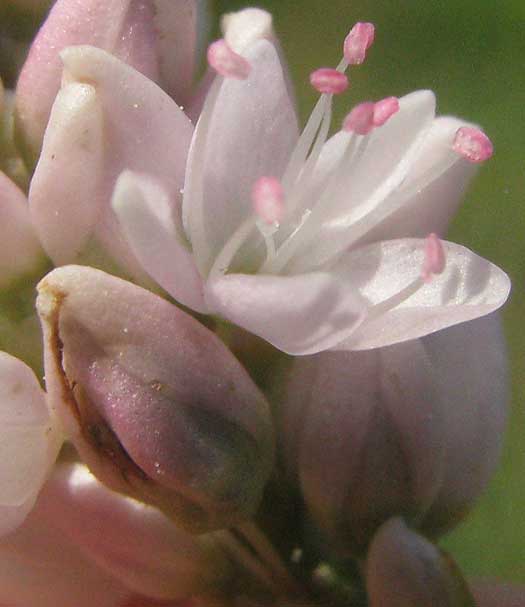Excerpts from Jim Conrad's
Naturalist Newsletter

from the June 15, 2014 Newsletter issued from the Frio Canyon Nature Education Center in the valley of the Dry Frio River in northern Uvalde County, southwestern Texas, on the southern border of the Edwards Plateau; elevation ~1750m (~5750 ft); N29.62°, W99.86°; USA
PENNSYLVANIA SMARTWEED
In the bottom of a drainage ditch in Uvalde the weeds were lush and green as they were nowhere else in town, and someof the weeds, about belly high, bore stiff, slender peduncles at their tops tipped with spike-like flowering heads that looked like pale, pink caterpillars standing on their heads. This is seen above.
This plant's general form and presentation of flowers is so distinctive, and the plant-type so commonly encountered, that most fans of wildflowers and weeds instantly recognize it as a kind of smartweed, also known as knotweed, of which maybe 55 species are listed for North America. When I was learning my botany, smartweeds were placed in the genus Polygonum, but since then numerous species known as smartweeds have been exiled to the genus Persicaria, and this is one of them. In fact, in eastern and central North America it's one of the most commonly occurring and easily recognizable smartweed species. It's the Pennsylvania Smartweed, sometimes called Pinkweed, PERSICARIA PENSYLVANICUM.
When you think you have a smartweed but want to confirm it, you need to look for a vegetative feature that serves as a very good field mark for the family to which smartweeds belong, which is the Buckwheat Family, the Polygonaceae. That field mark is the cylindrical sheath or "ocrea" completely surrounding the stem wherever a leaf's petiole attaches to the stem. Below, you can see the Pennsylvania Smartweed's ocrea:

Some ocreas bear atop their top edges conspicuous hairs, but you can see that Pennsylvania Smartweed's don't, and that's one important field mark for this species. The above picture shows another important distinction of the Pennsylvania Smartweed, which is that its stems are heavily invested with tiny, dark, sticky glands held atop short, stiff hairs -- they're "glandular hairs." Most smartweed species don't have these.
It's interesting that these important diagnostic features are vegetative, not sexual -- not details of flowers or fruits. In most cases it's the other way around. Below, you can see Pennsylvania Smartweed's flower which is, though pretty enough, not much different from flowers of many other smartweed species:

One feature seen in that flower that's typical of the entire Buckwheat Family is that the petal-like, colorful parts are neither the petals of a corolla nor the normally green sepals of a calyx, but rather they are simply undifferentiated, look-alike lobes functioning as if they were corolla petals. In such a case the collection of colored, corolla-like parts is referred to as a perianth.